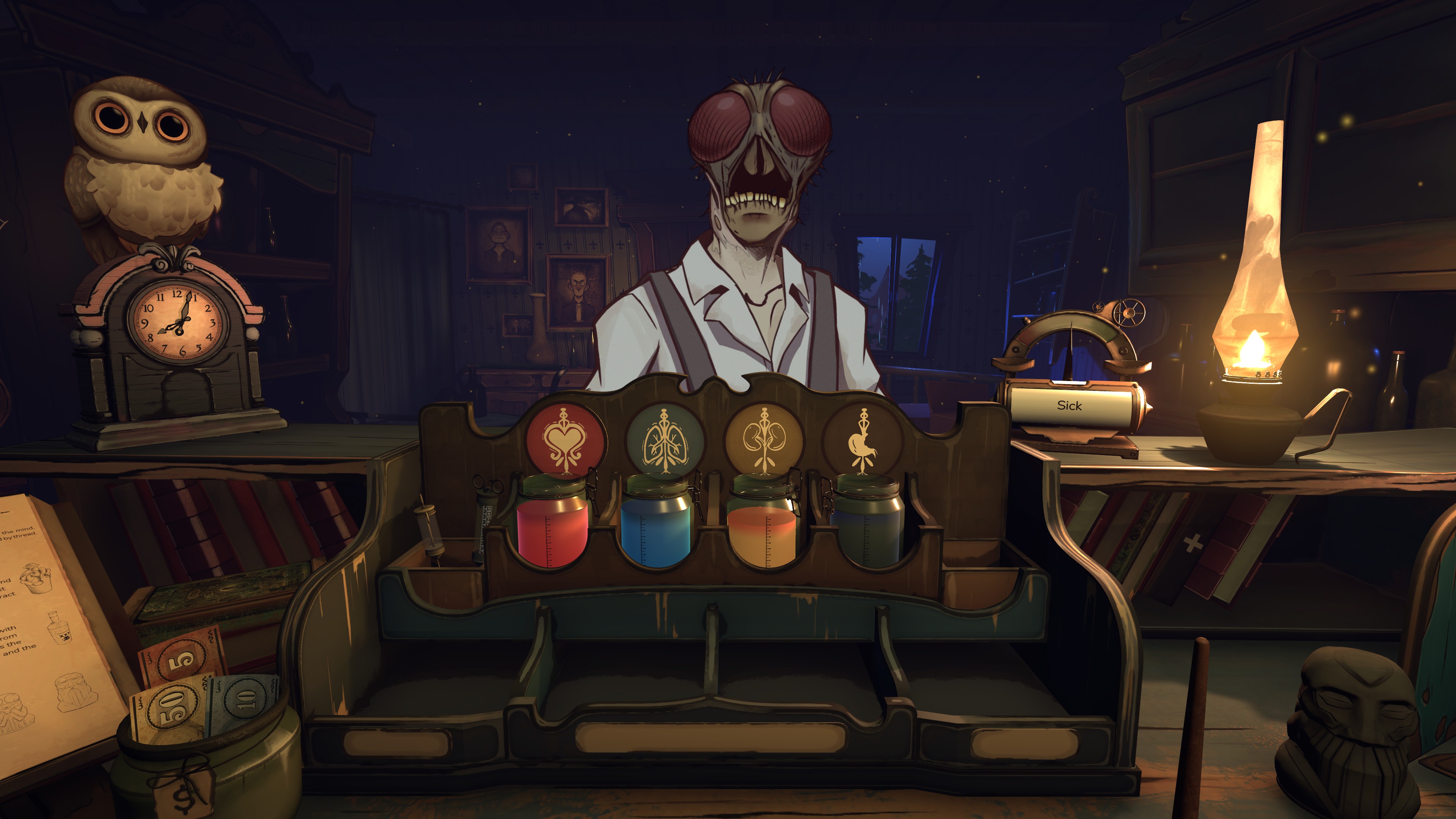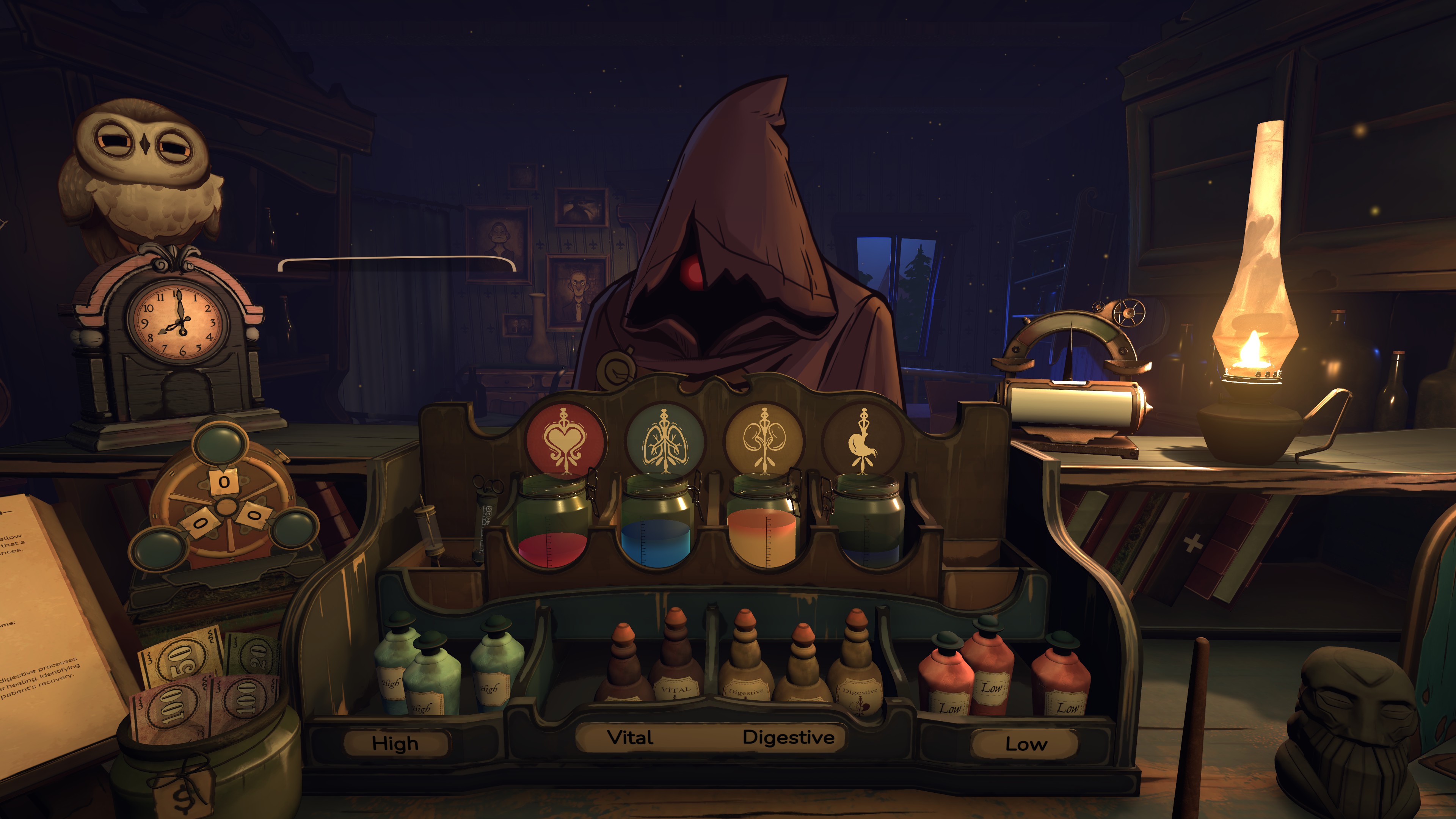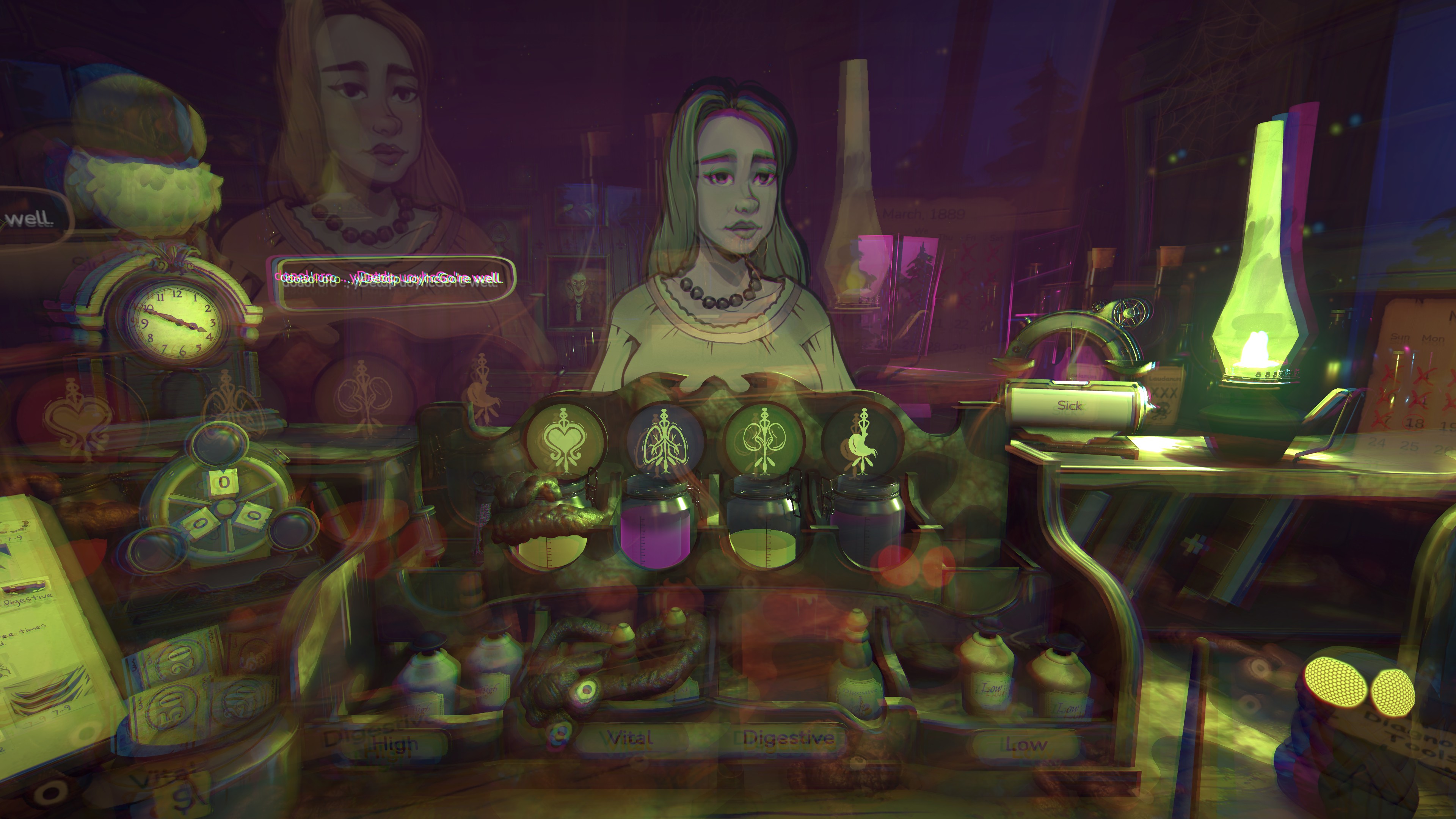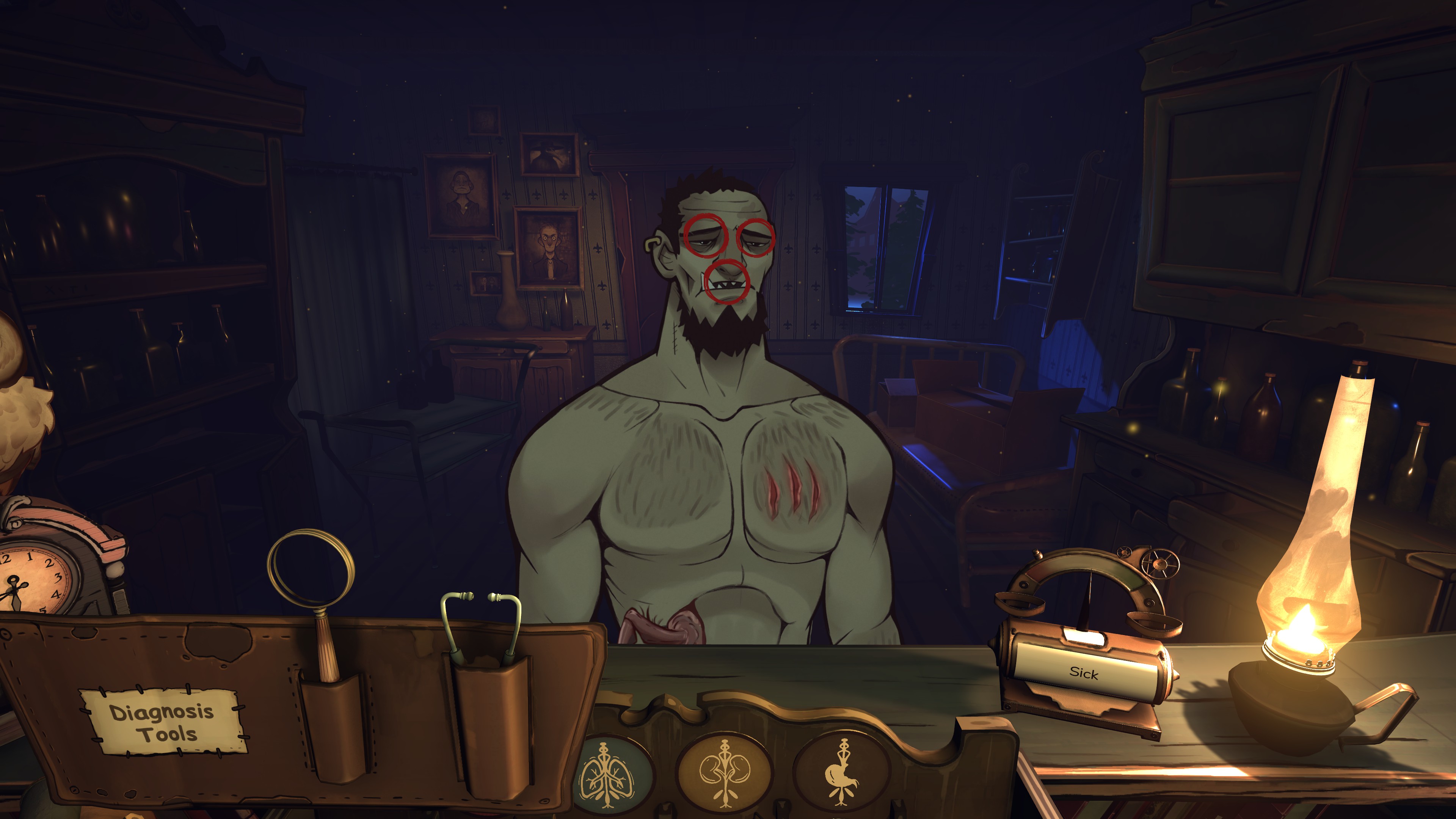
The first patient I killed was a mistake. A burly fellow named Victor Harlow walked into my surgery complaining about fatigue, but I was distracted by the little pig popping in and out of my cuckoo clock. This isn't a euphemism for anything—there really was a small pink pig where the cuckoo should have been.
Anyway, I downed an entire bottle of laudanum and the pig went away. I gave Victor a shot of blood medicine (this is medicine for treating blood-related illnesses, not medicine made of blood, although it is the same colour) and he just keeled over, his spirit leaving his body like steam from a kettle.
I still don't know what happened. Maybe I got the dosage wrong, or misinterpreted his symptoms. In any case, the point is it was an accident. As for all the others, well, we'll get to them.
I was drawn to Do No Harm by its brilliant three-word premise: Lovecraftian doctor simulator. These words do little for me individually. I never wanted to be a doctor, or even pretend to be a doctor, while videogames have thoroughly exhausted Lovecraftian horror for me. But for some reason, the combination resonated with me, and I opened up a new practice under the name "Doctor Eadful". I was rather pleased with this name, until I realised the game fills in the 'Dr' part for you. Consequently, my character's name is actually "Dr. Doctor Eadful", which is arguably funnier than what I was going for.
Do No Harm plays a little like the spooky botany adventure Strange Horticulture. It's a blend of narrative adventure and light deductive puzzling set around the daily routine of serving customers. Instead of people coming to you asking to buy weird plants, however, they arrive seeking treatment for illnesses.
Healthscare
This all starts simply and benignly enough. A patient will walk through your door complaining about a symptom like itching or a stomach ache, and you look it up in your big book of Victorian medicine for dummies. The symptom will be listed under one of the four humours, and all you need to do is inject your patient with the matching medicine.
Yet Do No Harm quickly complicates proceedings. The addition of a new syringe requires you to deduce the appropriate dosage of medicine to administer, as well as the type of remedy, while you also begin to receive patients who don't know exactly what is wrong with them. At its most complicated, you'll need to identify multiple symptoms using tools like a stethoscope and magnifying glass, then synthesise cures from multiple types of medicine.
Keep up to date with the most important stories and the best deals, as picked by the PC Gamer team.
If you treat patients incorrectly, they'll get sicker, turning green, sweating profusely, and in the extreme, outright expiring. And naturally, this being a Lovecraftian affair, there are other challenges to contend with. Your good doctor starts experiencing hallucinations, like the clock running backwards, hearing voices through his stethoscope, or giant, livid eyes peering into your shop windows. A dose of laudanum taken immediately will dissipate these phantasms, but if you miss one, it'll chew a hole in your sanity, and the bug-eyed totem on your desk will chastise you for your negligence.
As Do No Harm progresses, the balancing act becomes increasingly difficult, with you striving to diagnose patients while your eyes flit around the background for signs of madness. It was such distractions that led me to inadvertently kill poor Victor. Dead patients damage your reputation with the village and arouse the suspicion of the local police constable. But more importantly, dead patients don't pay for their treatment, and you need that money to replenish your medical supplies.
Victor's death was the point where things began to spiral. After the slipup, I started investigating cases more thoroughly. But this meant I was treating fewer patients per day, therefore earning less money overall. Several of the villagers tried to assist, like the local reverend who shared highly specific details of several patient illnesses with me. I'm pretty sure he shouldn't have done that, but it was useful.
Yet even with such help, I rapidly ran short on money. Which is when the local gravedigger rocked up, handed me a list of people, and offered me a big sack of cash if I slipped up again when they came for treatment.
Deathbed
Naturally, I was aghast, but at the same time, if I didn't get my hands on some money soon, my patients were going to start dying anyway. So when Balthazar Wifflepuff came in complaining of diarrhoea, I might have mixed the wrong medicines together to treat it, and when Charles Murray arrived with a bad case of vomiting, I possibly gave him a dosage of medicine that set off his egg allergy. Obviously, I feel terrible for those poor souls. But their sacrifice meant the rest of my patients didn't have to worry about medicine shortages any longer.
This is what Do No Harm does best. The various pressures on your doctor, the visions, your finances, the manipulative offers and threats by various members of the community, slowly push you toward making decisions that you would reject outright in a more conventional choice-based RPG.
I didn't want to give my patients the potion that crazy-looking cultist gave me, but he strongly implied he'd kill them if I didn't. I suspected the reverend might have ulterior motives for giving me that list of patients, but I was overwhelmed and the cures were right there. I might have killed the patients on the gravedigger's list. But I swear I'm not a murderer. Can't you see? I did it for the greater good.
Naturally, the police didn't see it that way, and opened an investigation into my practice. Not that it ultimately mattered. While I did the best I could for my patients (well, most of them) I couldn't stop my own mental health from slipping. There are numerous endings to Do No Harm, and without wanting to spoil anything, I got the one that occurs when your sanity hits rock bottom.
Do No Harm's systems can be a little obscure, and it sometimes punishes you unfairly, like dinging you for not noticing hallucinations that only appear if you use a certain tool. Otherwise, it's the most interesting Lovecraftian game I've played for a while. Its narrative tightrope is elegantly weaved, but more importantly, falling off that tightrope is arguably truer to one of Lovecraft's weird tales than safely navigating your way along it. I was an utterly horrible doctor who killed multiple people and went mad, and as they drag me away howling in my straightjacket, know that I don't regret any of it.
Rick has been fascinated by PC gaming since he was seven years old, when he used to sneak into his dad's home office for covert sessions of Doom. He grew up on a diet of similarly unsuitable games, with favourites including Quake, Thief, Half-Life and Deus Ex. Between 2013 and 2022, Rick was games editor of Custom PC magazine and associated website bit-tech.net. But he's always kept one foot in freelance games journalism, writing for publications like Edge, Eurogamer, the Guardian and, naturally, PC Gamer. While he'll play anything that can be controlled with a keyboard and mouse, he has a particular passion for first-person shooters and immersive sims.
You must confirm your public display name before commenting
Please logout and then login again, you will then be prompted to enter your display name.






